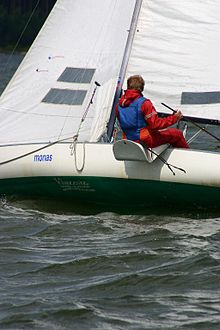Horseback riding (sailing)
By riding out , the trim of a sailboat , i.e. the best possible setting of the sails in relation to the desired speed and prevailing wind direction , is improved by using the body weight of the crew.
When riding on a larger sailing yacht , all or part of the boat crew positions themselves on the windward side of the boat in order to counteract the heel and to keep the sailboat upright by their body weight.
Because of the lack of a ballast keel , riding out on dinghies is necessary to keep these swordboats in an optimal position and to prevent capsizing. The sailor hangs his feet in riding straps so that he can lean his upper body far over the edge of the boat. The sometimes padded riding belts are attached to the floor of the cockpit and are similar in material and appearance to the seat belts in automobiles.
Certain keelboat classes such as the Monas or the Fighter have fold-out riding seats so that you can shift your body weight further to the windward side. This type of riding is more back-friendly than the variant with the riding straps on dinghies.
Another technique to sail a boat upright is so called trapeze sailing .


